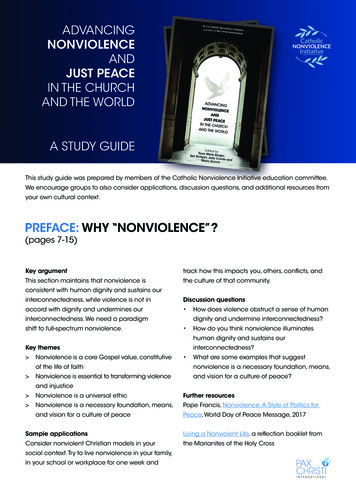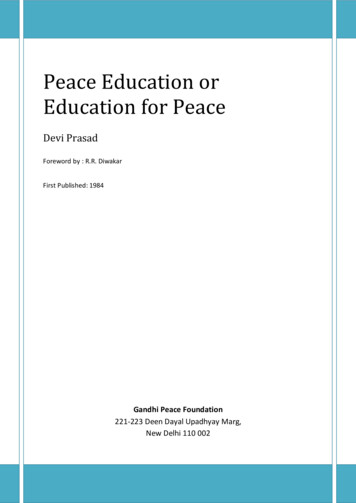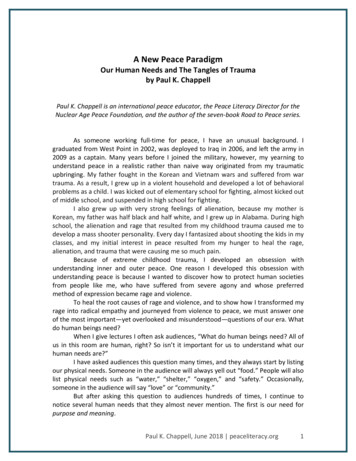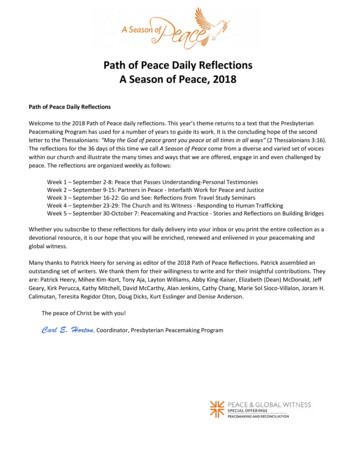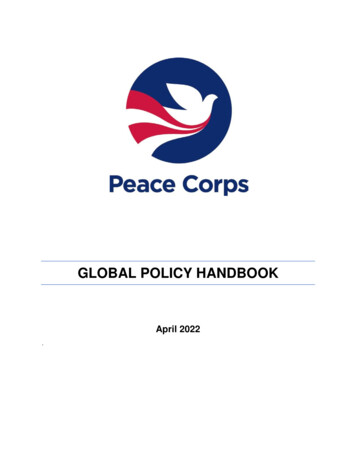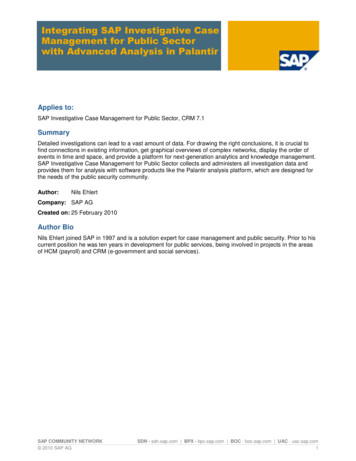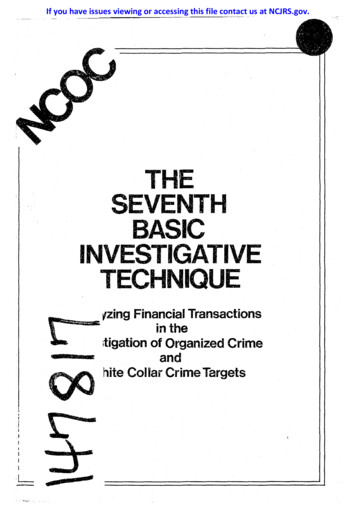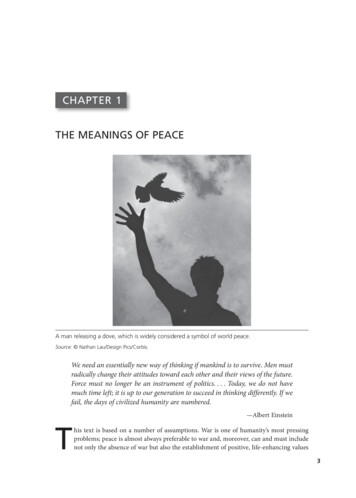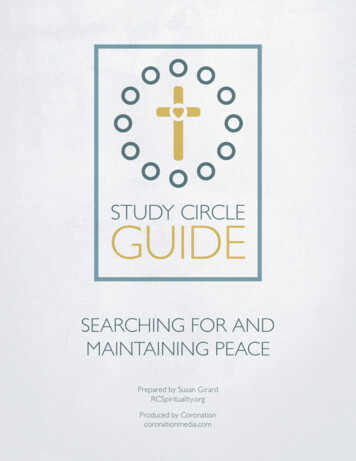
Transcription
THE PEACE MODEL OF INVESTIGATIVE INTERVIEWING:A COMPARISON OF TRAINED AND UNTRAINED SUSPECT INTERVIEWERSby W. Todd BarronA Thesis submitted to theSchool of Graduate Studiesin partial fulfillment of the requirements for the degree ofMaster of ScienceDepartment of PsychologyMemorial University of NewfoundlandOctober 2017St. John’s, Newfoundland
ABSTRACTThe peformance of police interviewers trained to use a science-basedinterviewing protocol – known as PEACE – was compared to interviewers who were nottrained. Specifically, a sample of real-life suspect interviews by PEACE-trained (n 25)and untrained (n 27) interviewers were coded for the existence of engage and explainbehaviours, police cautions and charter rights, question types, coercive tactics, evidencebased challenges, along with interview (confessions and information provision) and court(pleas, convictions) outcomes. Results showed that PEACE-trained interviewers usedsignificantly more engage and explain behaviours, and fewer coercive tactics. Trainedinterviewers were found to use more open-ended questions, more clarifications, morestatements, and fewer leading questions and facilitators. Results also showed that peopleinterviewed by trained interviewers provided significantly greater amounts of informationthan those interviewed by untrained interviewers. It was also found that there were fewdifferences in the administration of legal rights, confession rates, and court outcomesbetween trained and untrained interviewers. The effect of PEACE training oninvestigative interviewing and truth-seeking is discussed.Keywords: investigative interviewing; PEACE; suspects; police; training.ii
ACKNOWLEDGEMENTSI would like to thank Dr. Brent Snook for his continuous encouragement,mentoring and friendship without which this journey would not have been possible.I would also thank my MASP cohort for their in-class help and motivation(Ashley Baker, Sally Payne, and Bruce Dibben). Much appreciation and thanks is alsoextended to Dr. Kirk Luther, Dr. Sarah MacDonald, Zachary Keeping, ChristopherLively, and Weyam Fahmy for all their help and support.Last, but certainly not least, I would like to thank my wife Lori and my childrenCaelan, Jeremy, and Rebecca. You are my inspriation when times are tough and alwaysmy shining light. Lori without your encouragement I would not have allowed myself tobelieve I could.iii
TABLE OF CONTENTSABSTRACT . iiACKNOWLEDGEMENTS . iiiTable of Conents . ivList of Tables . viChapter 1: Literature Reivew . 7Canadian Policing Statistics and Autonomy . 7Custodial Interviewing . 9The Evolution of Suspect Interviewing . 11Judging Guilt with the Flip of a Coin . 18The Effect of Psychologically Manipulative Practices on Confession Reliability. 20The Confession Rule . 23The Humane Stage: The PEACE Model . 25Planning and Preparation . 25Engaging and Explaining. 26Account Elicitation . 26Closure and Evaluating . 28Evaluating PEACE . 29Empirical Studies on Suspect Interviewing in Canada . 32Interviewing Training: Personal Communications . 34The Effects of Suspect Interview Training on Practice . 35The Current Study . 36iv
Chapter 2: Method . 37Design . 37Sample Selection and Description . 37Materials and Procedure . 39Coding Procedure . 40Inter-Rater Reliability. 43Chapter 3 Results: . 44Engage and Explain Behaviours . 44Legal Rights . 44Question Types . 48Coercion . 50Challenging Inconsistencies . 50Interview and Court Outcomes . 51Chapter 4: Discussion . 55References . 63Appendix A: Content Dictionary . 71Appendix B: Coding Guide. 87v
LIST OF TABLESTable 1. The Percentage of Engage and Explain Behaviours as a Function ofExperimental Condition . 46Table 2. Mean Percentages of Each Question Types as a Function of Condition . 49Table 3. The Mean Number of Times (Standard Deviation) a Coercive Tactic was UsedPer Interview, as a Function of Experimental Condition . 53vi
Chapter 1: Literature ReviewAs with all police organizations around the world, interviews with suspects andaccused persons are integral to the investigation of crime in Canada. Although there is agrowing body of empirical literature that is starting to inform interviewing practices inCanada, much of what has driven investigative interviewing is based on commonsensenotions of what should work and, more recently, empirically-driven guidance on whatactually works. There has been a major advancement in Canada over the last eight yearswhere the scientifically-driven PEACE Model of Investigative Interviewing (P-plan andpreparation; E-engage and explain; A-account; C-closure; E- evaluate, henceforth referredto as PEACE) is challenging previously cherished beliefs and practices. As with anypromising development, there has been an anticipated resistance to change and questionsabout the effectiveness of this novel method. Consequently, the goal of the currentresearch is to test the extent to which those who have received PEACE training are usingbest practices in reality beyond what exists for those without that training.Canadian Policing Statistics and AutonomyPublic-sector policing in Canada consists of four levels, including municipal,provincial, federal, and First Nations. As of 2013, there were nearly 70,000 police officersin Canada. The Royal Canadian Mounted Police (RCMP) is Canada’s largest policeorganization (and only federal one) with over 17,000 members – the RCMP is contractedprimarily by the provinces and territories to service rural areas. The provinces of Ontario,Québec, and Newfoundland and Labrador have provincial police forces – the OntarioProvincial Police, Surete de Quebec, and The Royal Newfoundland Constabulary (RNC),respectively. Outside of the RNC, every major city in Canada is policed by a municipal7
police organization (e.g., Toronto Police Service, Montreal Police Service, VancouverPolice Service). There are more than 150 police organizations in Canada(www.mypolice.ca).Perhaps most important for understanding police interviewing in Canada,however, is the fact that policing is primarily a provincial responsibility – that is, eachprovince may have its own specific mandates and practices. Granted, policing in Canadais informed somewhat by jurisdictional sharing and numerous organizations such as theAssociation of Chiefs of Police (responsible for a wide mandate which includesconsultation with professional and community partners, advancement of legislative andpolicy reform), Canadian Police College (responsible for advanced and specialized policetraining), and the Canadian Police Knowledge Network (responsible for online trainingsolutions for law enforcement). Within provincial guidelines and the legal rules ofinterviewing in Canada, each police organization is free to employ any suspectinterviewing practice(s) it desires; the extent to which any chosen suspect interviewingapproach/tactics prevents a statement from being admitted into evidence ultimatelyresides with a judge. Such autonomy ultimately makes it impossible to make broad,general statements regarding suspect interviewing practices in Canada.It is also important to note that the choice of interviewing practices of policeorganizations is seemingly influenced heavily by the organization’s polygraphexaminer(s). Polygraph examinations are used widely in Canada for pre-employmentscreening, and the testing and interviewing of suspects. Members of police organizationsselected to become polygraph examiners attend a three-month program at the CanadianPolice College in Ottawa where they receive extensive training in polygraph8
examinations and suspect interviewing. Upon return to their organization, they are for allintents and purposes, the expert who sets the organization’s interviewing policy andpractices.Custodial InterviewingThere are two broad types of interviewing in Canada – custodial and non-custodial(Kelly, Miller, Redlich, & Kleinman, 2013). A custodial interview refers to when anindividual is questioned after being taken into custody by law enforcement officials (i.e.,arrested or detained). Custodial interviews are usually conducted in a police station.However, if an individual is questioned by the police without being arrested, but feels thathis/her freedom is limited (i.e., psychological detention), this would also be considered acustodial interview. As individuals are deprived of their rights and freedoms during acustodial interview, they must be advised of their constitutional rights under The Charterof Rights and Freedoms (i.e., Right to Silence, Right to Legal Counsel). By contrast, anon-custodial interview refers to when a suspect is interviewed, s/he is notarrested/detained, and the interviews may occur outside the confines of a police station.Individuals undergoing a non-custodial interview do not need to be informed of his/herconstitutional rights. The current research focuses upon custodial interviews.Suspects and accused persons who undergo a custodial interview in Canada areafforded legal safeguards under the Canadian Charter of Rights and Freedoms (henceforthreferred to as The Charter), and guidance from case law. That is, suspects must beinformed of their right to silence and right to legal counsel, which are derived fromsections 7 and 10b of The Charter, respectively. Section 7 of The Charter states that“Everyone has the right to life, liberty and security of the person and the right not to be9
deprived thereof except in accordance with the principles of fundamental justice.” InCanadian case law, the right to silence means that suspects and accused persons must begiven a free choice about whether to speak to the police (see R. v. Hebert, 1990). Whilethose questioned by the police are not lawfully compelled to answer any questions, policeofficers are also not compelled to cease their questioning (R. v. Singh, 2007). Thus,continued questioning of a suspect after s/he has invoked his/her right to silence ispermitted under Canadian case law, and any confession obtained through this mannermay still be admissible in court. However, persistent questioning once a suspect hasinvoked this right may lead to a confession being deemed involuntary (e.g., R. v. S. (D.),2010).The right to legal counsel is contained in section 10b of The Charter and statesthat: “Everyone has the right on arrest or detention to retain and instruct counsel withoutdelay and to be informed of that right.” As clarified in subsequent cases R. v. Bartle(1994) and R. v. Brydges (1990), prior to being questioned by the police, suspects must benotified of: (a) their right to retain and instruct counsel without delay; (b) informationabout access to counsel free of charge where an accused meets prescribed financialcriteria set up by provincial Legal Aid plans; (c) information about access to immediate,although temporary, legal advice irrespective of financial status (“duty counsel”); and (d)basic information about how to access available services which provide free, preliminarylegal advice. In addition, while a suspect does not have the right to have their lawyerpresent during the interview (R. v. Sinclair, 2010), they do have the right to contact alawyer of their choice (R. v. McCrimmon, 2010) and be given reasonable time to contactsaid lawyer (R. v. Willier, 2010).10
Case law over the past decade has clarified and provided a precise framework ofwhat police officers are permitted to do during an interview, along with the legal rightsafforded to those being interviewed, under The Charter. In saying this, it is also importantto mention a key piece of case law, R. v. Oickle (2000), which outlines the confessionrule. The confession rule provides guidance on the factors necessary to determine whethera confession was made voluntarily. If a confession was made involuntarily, it may beexcluded from trial. In the Oickle ruling, the Supreme Court of Canada stated four factorsthat should be considered by judges when determining whether a confession was madevoluntarily: (a) the extent to which the suspect was of sound operating mind whenquestioned by the police; (b) the use of threats or promises (e.g., no quid pro quo offers),(c) the presence of an oppressive environment (e.g., subject the suspect to inhumaneconduct), and (d) the presence of police trickery (however, some trickery is permitted aslong as it does not shock the community).The Evolution of Suspect InterviewingInterviews in Canada have, for the most part, evolved from those that weredominated by physically abusive ‘third degree’ practices to those dominated bypsychologically manipulative ones (Leo, 2008; but see R. v. Singh, 2007 for a recentexception in Canada). In recent years, interviews in Canada have been evolving throughthe emergence of PEACE.Leo’s (2008) review of the available literature on American interrogation practicessuggests that up until 1931 (and at least far back as the middle of the 19th century) it wasnormal for police officers to use ‘third degree’ tactics when interrogating detainees. Thirddegree tactics included different types of physical force and abuse, isolation, and11
deprivation of basic necessities such as food and water. It is thought that policeinterrogators got tough on criminals because they perceived themselves to be at war withcrime and that the third degree was their most effective weapon in securing confessions.Police officers were, as they are today, keenly aware that a confession is a very powerfulpiece of probative evidence. It also appears that the police organizations rationalized theuse of such tactics by assuming that they only interrogated guilty individuals. Thirddegree tactics were seen as a necessary evil to seeking the truth because it would makeotherwise uncooperative criminals talk, and it was much more expedient to get the guiltyperson to confess than having to prove guilt through the painstaking collection ofevidence. Interestingly, such a pugnacious approach was seemingly unchallenged by thejudiciary at that time.Leo (2008) argued that the release of “The Report on Lawlessness in LawEnforcement” in 1931 was the catalyst for the demise of third degree tactics. Policeorganizations came to realize that physical and psychological torture produced unreliableinformation, elicited confessions that were inadmissible in court, lowered publicconfidence in policing, and impeded the desire to professionalize policing. In addition,police organizations eventually realized and grew concerned that innocent people weresometimes exposed to abusive practices (see similar concerns raised regarding CriminalIntelligence Agency interrogation practices and critiques; Mazzetti, 2014)Psychological tactics replaced physically abusive practices gradually. Essentially,the use of physical abuse as an interrogation approach was obsolete by the mid-1960s(Leo, 2008). The modern-day approach to interrogations is based largely on theexperiences of Chicago polygraphist John Reid. The Reid Technique (henceforth referred12
to as Reid) was first described in-depth in 1962 in the book Criminal Interrogation andConfessions. The book is now in its 5th edition, and the method has subsequently beentaught to hundreds of thousands of investigators around the world (Buckley, 2006). Reidconsists primarily of two main phases: the behavioral analysis interview (BAI) and thenine-step interrogation (Inbau et al., 2013).The BAI interview is a 15-item non-accusatory interview that is meant to assessguilt. The underlying assumption is that guilty individuals will provide answers to thequestions that are quite distinct from the answers provided by innocent individuals. Morespecifically, it is assumed that guilty people will be more evasive and provide ambiguousor noncommittal answers (Massip, Barba, & Herrero, 2012; Vrij, 2008). Consider thefollowing example of one of the BAI questions (“purpose”): “Jim, what is yourunderstanding of the purpose for this interview with me here today?” This question ispresumed to result in one of two responses (Inbau et al., 2013). The first response mightbe “I suppose you want to talk to me about what happened at the warehouse”. The secondresponse might be “I’m sure you want to find out what I know about the arson at work”.Which of these responses indicates guilt? According to Inbau and colleagues, an innocentperson will provide an answer that is similar to the second example because it is more“direct and contains realistic language”.The BAI is a critical step for an interrogator who follows the Reid trainingbecause it places the onus on the interrogator to interpret and assess human behaviouraccurately. Given the fact that there is no objective guidance on how to score the patternof answers to the BAI questions, officers are left to their own devices to sort out who isinnocent and, more crucially, who is guilty. Only those individuals who are judged guilty13
are subsequently subjected to an accusatory interrogation. To be clear, interrogatorsfollowing Reid are taught that they never interrogate innocent people.The accusatory interrogation is comprised of nine steps that aim to elicit aconfession from an individual through a pressured-filled interview (Kassin, 2008). The‘get tough’ philosophy of this interrogation process is summed up, in part, by thefollowing quote from their training book: “investigators must deal with criminal suspectson a somewhat lower moral plane than that upon which ethical law abiding citizens areexpected to conduct their everyday affairs” (Inbau et al., 2013). Reid-based interrogationsoperate on a “lower moral plane” through theme development (implicit promises ofleniency), prevention of denials, using objections to reinforce themes, the use of analternative question technique, and the use of (implicit) false evidence ploys. Below is anoutline of the Reid technique (as per Inbau et al., 2013).Step 1 of Reid involves a direct, positive confrontation with a detainee.Interrogators are taught to state their unwavering belief in the detainee’s guilt, and tofollow the confrontation with a pause so that the detainee’s non-verbal and verbalresponses can be scrutinized. Interrogators are taught to examine an “evidence folder”(which can contain blank pages) to communicate to the detainee that the interrogator hasproof of guilt, and to use a transition statement (also known as a theme) that provides theguilty person with a reason for why the interrogation is taking place given that their guiltis assured.In the Step 2, interrogators are encouraged to develop a theme that provides areason to the guilty party as to why they committed the crime. According to Inbau andcolleagues (2013), interrogators should distinguish between emotional offenders (i.e.,14
those who express guilt or shame about their crime) and unemotional offenders (i.e., thosewho do not express feelings of guilt or shame). For emotional offenders, the interrogatorsare taught to minimize the crime by suggesting moral excuses or justifications.Interrogators are also taught that the chosen theme should reinforce the individual’srationalizations for committing the crime to make it easier for a guilty person to overcomeany hesitations associated with admitting their criminal involvement. For unemotionaloffenders, interrogators are taught to reason with detainees and persuade them to confess.If a theme continues to be rejected, different themes should be presented in an effort tofind one that matches the detainee’s identity.Step 3 involves handling denials. Interrogators are taught that confessions occurrarely after detainees are confronted directly about their guilt and that they should expectguilty individuals to deny the offense. Allowing initial denials of criminal involvementpresumably reduces the likelihood of obtaining a confession at a later stage in theinterrogation. The primary goal of this third step is for the interrogator to preventdetainees from denying involvement in the crime by, for example, reconfirming one’sbelief in their guilt and reiterating the proposed theme after preventing denials from beingvoiced.The purpose of Step 4 is to overcome objections – excuses given by detainees asto why they could not, or would not, have committed the crime. Objections can beemotional (e.g., “I’d be too nervous to do something like that”), factual (e.g., “I don’teven own a gun”), or moral (e.g., “I wasn’t brought up that way”). Because it is assumedthat only guilty detainees verbalize objections, a movement from denials to objections isassumed to be a good indication of deception. Unlike denials, objections should be15
permitted because they can be used to further the development of a theme—namely, byproviding the interrogator with an opportunity to turn the objection around to match theproposed theme.Step 5 involves the procurement and retention of the detainee’s attention. Afterbeing discouraged from expressing denials and having their objections turned around tosupport the interrogator’s proposed theme, guilty individuals (not the innocent) maypsychologically withdraw and ignore the interrogator. At this point, interrogators aretaught to use techniques that maintain the detainee’s attention—for example, by inchingtheir chair forward into the detainee’s physical space or increasing direct eye contact.The purpose of Step 6 is to recognize and overcome passive moods. After the detainee’sattention is procured successfully, the detainee is presumed to be more willing to listenbut may physically appear defeated or start crying. At this stage, interrogators are taughtto concentrate on a specific theme, display understanding and sympathy, and urge theindividual to tell the truth. Interrogators are taught to use such techniques until thedetainee shows signs of mentally considering whether to tell the truth (e.g., withnonverbal agreement such as nodding).The presentation of alternative questions in Step 7 represents the culmination oftheme development. An alternative question presents the guilty party with a choicebetween two explanations for the commission of the crime (e.g., “Did you plan therobbery or was it a spur of the moment decision?”). One of the choices is face-saving andone more reprehensible, but both involve an admission of guilt. Alternative questionsallow an individual to save face while providing the interrogator with an incriminatingadmission. Interrogators are also taught to offer reinforcing statements if the person16
accepts one of the alternatives. For instance, the interrogator might state, “Good, that’swhat I thought.”Step 8 involves having the detainee verbalize the details of the offense. After adetainee makes an admission of guilt, the interrogator is encouraged to show signs ofsharing the detainee’s relief and to draw the individual into a conversation to fullydevelop the confession. When general acknowledgment of guilt is achieved, theinterrogator is encouraged to return to the beginning of the crime and obtain informationthat can be corroborated.Step 9 involves converting the oral confession into a written confession. This finalstep is thought to be important because it is assumed that a written confession reduces thepossibility that an individual will retract the confession and, if he or she does, it helps toensure the confession will stand up in court. Inbau and colleagues (2013) recommendconverting the oral confession into a written and signed confession as soon as possible; itmay be prepared in the form of questions and answers or as a narrative. When the writtenconfession is complete, it should be read aloud, corrected for any errors, and then signedby the detainee in the presence of a witness.Over the years, despite the movement away from the use of direct physical forceto psychologically manipulative and deceptive techniques such as Reid, little has changedwith regards to the protecting of innocent detainees from coercive interrogation. There aretwo interrelated concerns that have been highlighted with Reid: the use of unreliablebehaviourally-based deception detection methods and the use of tactics that are known toelicit confessions from innocent people.17
Judging Guilt with the Flip of a CoinAfter the release of the Wickersham Commission Report (1931), policeorganizations acknowledged more readily that they sometimes misclassified people asguilty and subjected innocent individuals to harsh interrogations. Like their predecessorsduring the ‘third degree’ era, modern day police officers attempt to differentiate betweenguilty and innocent individuals using various behavioural cues. This raises an importantquestion: Have police officers become better at distinguishing guilty and innocentpeople? The answer is no.Empirical research over the past 50 years has essentially put an end to the beliefthat police officers can detect deception with any degree of accuracy (Vrij, 2008). Ameta-analysis of deception judgments has shown that naïve individuals correctlyclassified 47% of lies as deceptive and 61% of truths as non-deceptive – the averageaccuracy of judgments was 54% (Bond & DePaulo, 2006). Research that has tested policeofficers’ abilities to detect deception has shown that their accuracy levels also tend tohover around chance levels, and that this accuracy level does not increase when realisticscenarios are utilized (Ekman & O’Sullivan, 1991; Mann, Vrij, & Bull, 2004). In otherwords, the maximum deception detection accuracy that can be achieved by lawenforcement officers is the same as simply flipping a coin. The lack of accuracy is largelybecause of mistaken beliefs regarding what cues are indicative of deception by membersof the legal community (e.g., gaze aversion, unnatural posture changes). Althoughattempts to train officers to detect deception by paying attention to relevant cues have18
resulted in moderate gains, the absolute levels of predictive ability ( 60%) remainunimpressive (e.g., Porter et al., 2010).Of particular concern when attempting to detect deception pertains to the use ofthe BAI. Research has shown that the BAI matches commonsense notions of what worksin deception detection, and there is no empirical evidence to support the underlyingassumptions about how guilty and innocent people will react to provoking questions(Massip & Herrero, 2013). The available research suggests that the underlyingassumptions are erroneous. In a seminal study examining how guilty and innocentparticipants reacted to BAI questions, no meaningful differences were observed in thereactions of guilty and innocent individuals for 12 of the 14 questions. In fact, theexpected reactions of guilty people for the remaining two questions were observed morefrequently for innocent individuals (Vrij, M
where the scientifically-driven PEACE Model of Investigative Interviewing (P-plan and preparation; E-engage and explain; A-account; C-closure; E- evaluate, henceforth referred to as PEACE) is challenging previously cherished beliefs and practices. As with any promising development, there has been an anticipated resistance to change and questions

